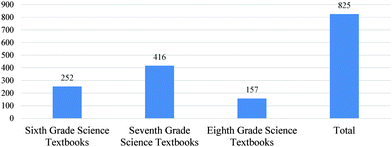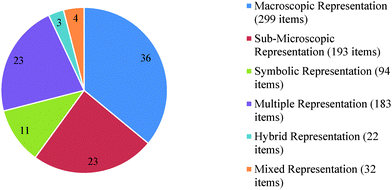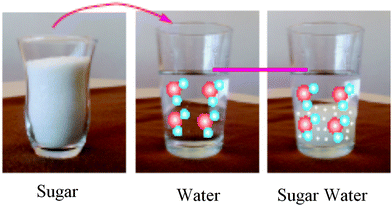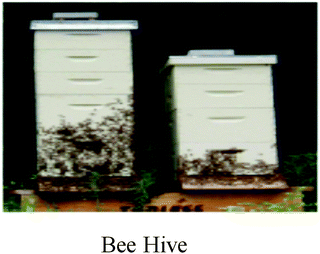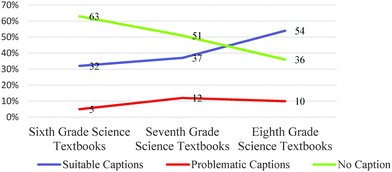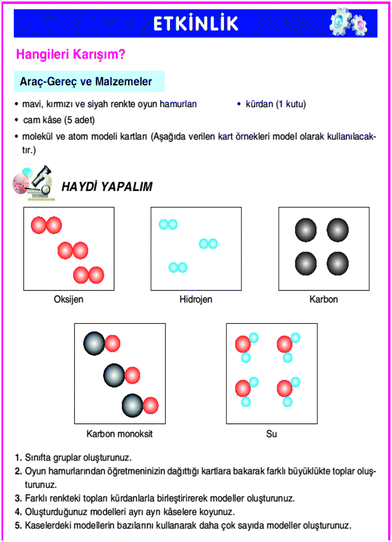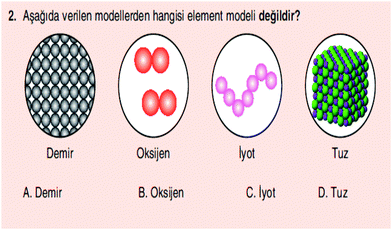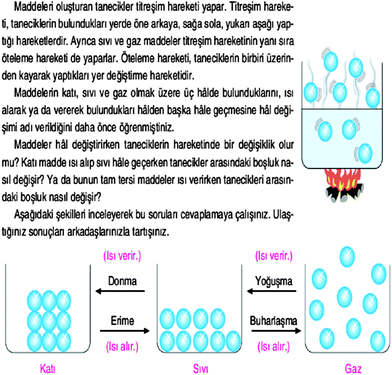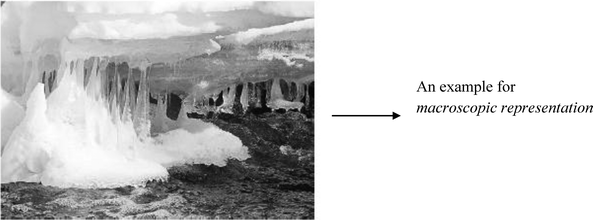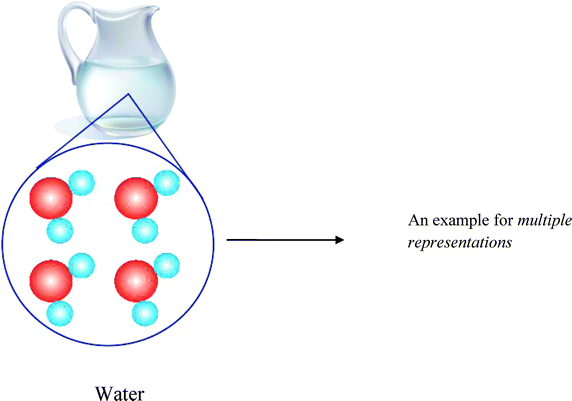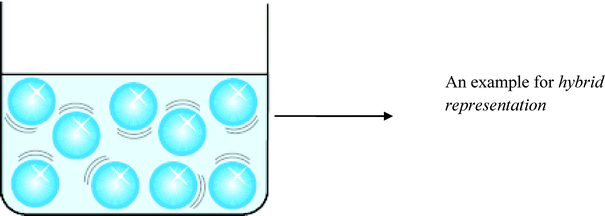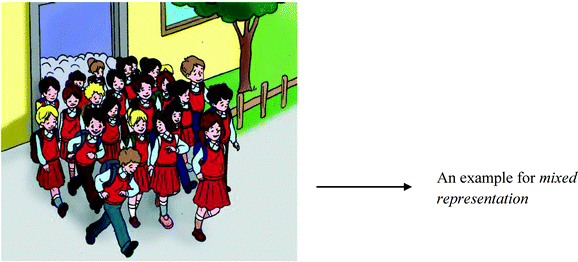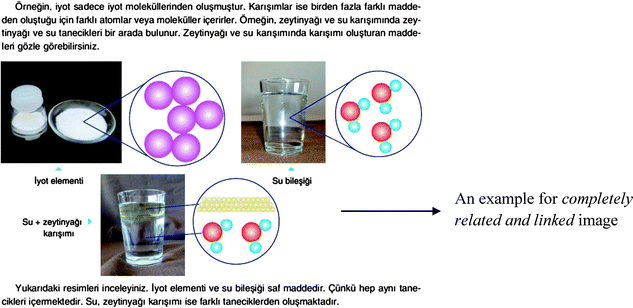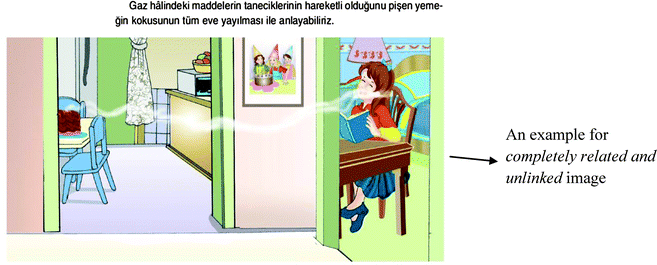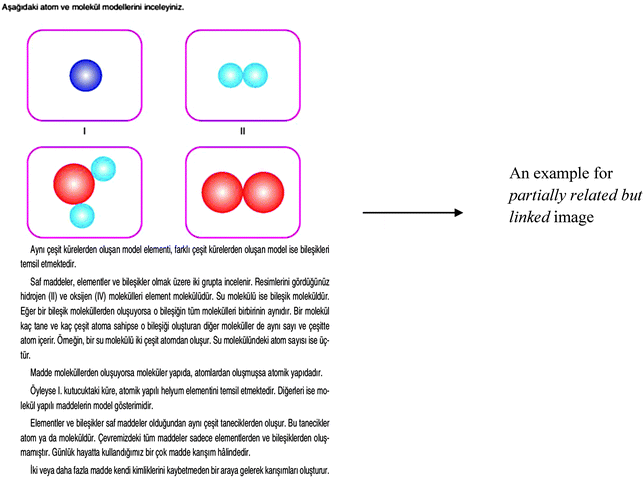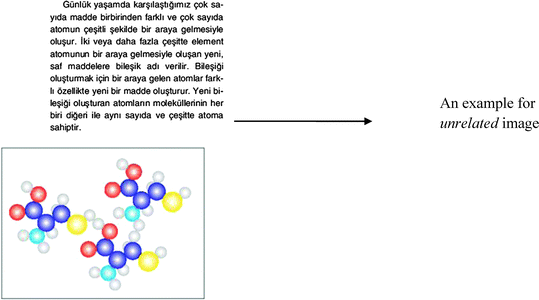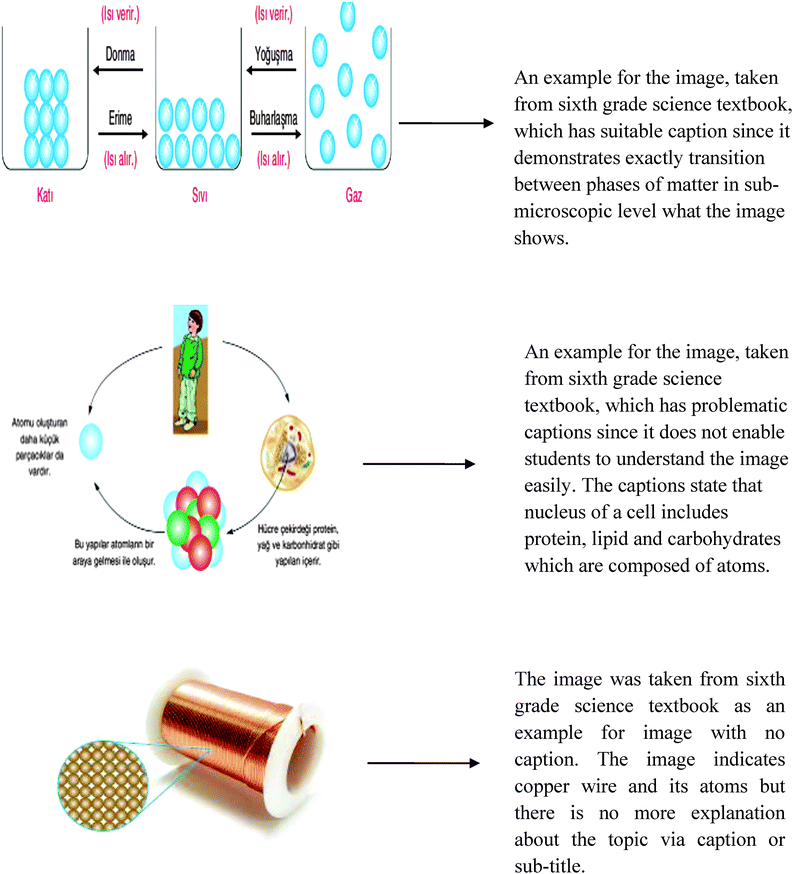Examination of visuals about the particulate nature of matter in Turkish middle school science textbooks
Hasan Özgür
Kapıcı
*a and
Funda
Savaşcı-Açıkalın
b
aYildiz Technical University, Turkey. E-mail: hokapici@yildiz.edu.tr
bIstanbul University, Turkey
First published on 2nd April 2015
Abstract
Textbooks are one of the primary teaching tools frequently used in schools and most teachers use them in their classrooms (Sanchez and Valcarcel, 1999). Since there are a lot of abstract concepts in science education, images in science textbooks play a vital role in the learning process (Kenan et al., 2011). Concretization of abstract concepts may ease students' understanding. For this reason, the aim of this study was to examine images about the particulate nature of matter (PNM) in Turkish middle school science textbooks. In other words, visuals were examined with respect to representational levels, relatedness to text, existence and properties of the captions. The rubric developed by Gkitzia et al. (2011) was used to evaluate the images from middle school science textbooks in selected units. A total of 825 images in Turkish middle school science textbooks were identified in related units. In addition, it was found that the most common representation type of images about the PNM in Turkish middle school science textbooks were macroscopic representations (36%). The relatedness of images to the text was also studied. It was concluded that just 4 out of 10 images were completely related and linked to the text. Lastly, it was found that more than half of the images about the PNM in Turkish middle school science textbooks had no caption.
Introduction
Textbooks are one of the primary teaching tools frequently used in schools and most teachers use them in their classrooms (Sanchez and Valcarcel, 1999). They facilitate students' learning not only as sources of information but also by helping them to enhance their knowledge of a topic through samples and exercises (Nakiboğlu, 2009). Textbooks are also effective references of what students are going to learn, what teachers are going to teach and which instructional method will be used through the learning process (Ertok Atmaca, 2006). For example, the study carried out by Chiappetta et al. (2006) showed that 90% of teachers benefit from textbooks for organizing their instructions and for setting homework. Therefore, textbooks have received a great deal of attention from scholars in science education (Chiang-Soong and Yager, 1993; Dökme, 2005; Han and Roth, 2005; Karamustafaoğlu and Üstün, 2005; Skoog, 2005; Irving et al., 2006; Tekbıyık, 2006; Niaz and Fernandez, 2008; Nakiboğlu, 2009; Çalık and Kaya, 2012; Şen and Nakiboğlu, 2012).Images in science textbooks play a vital role in the learning process as there are a lot of abstract concepts in science education (Kenan and Özmen, 2011; Özalp and Kahveci, 2011). Most students have difficulty in dealing with these abstract concepts (Zoller, 1990; Özalp and Kahveci, 2011). Hence, concretization of abstract concepts may ease students' understanding. Images are beneficial tools which help in the understanding of concepts, processes, and phenomena (Kress and van Leeuwen, 1996). If the concept or process is impossible to observe or if it is tiny or thumping to examine in a classroom environment, representations (pictures, symbols, graphs, signs) play a crucial role in their understanding (Buckley, 2000; Rapp, 2005; Cook, 2006). In addition, images are also used to motivate students by attracting their attention (Pozzer Ardenghi and Roth, 2005; Cook, 2006). Although there have been a lot of studies which have emphasized the importance of images in education, there has been relatively less research that has investigated the role of multiple representations in science education (Roth et al., 1998). Although teachers, researchers and curriculum developers are aware of the significance of visual representations theoretically, images have not reached their real potential in application in the educational environment (Roth et al., 1999).
Multiple representations in science textbooks
Textbooks are the most graphically populated print materials used for the communication and sharing of scientific ideas (Lee, 2010). If used well, they can be an effective tool for enhancing teaching and learning (Nyachwaya and Wood, 2014). If inconsistent use of models (representations) in textbooks are adopted in classroom teaching, students' learning becomes very problematic (Cheng and Gilbert, 2014). Most studies about images in textbooks (Roth et al., 1999; Dimopoulos et al., 2003; Pozzer and Roth, 2003; Han and Roth, 2005; Gkitzia et al., 2011) have found that the majority of representations in textbooks are photographs and pictures and are mainly of macroscopic concepts or processes. On the other hand, a common justification for multiple representations is using more than one representation simultaneously (Ainsworth, 1999). Ainsworth (1999) advocates that this catches students' attention and enables them to translate between representational levels. Representations play an essential role in communicating disciplinary knowledge for students' learning (Cheng and Gilbert, 2015). Representations used in books should facilitate students' understanding of chemistry concepts (Nyachwaya and Wood, 2014). Therefore multiple representations are powerful educational tools for students (Ainsworth, 2008). Diagrams, graphs, charts, equations, formulae along with words, photographs, illustrations and models are examples of multiple representations (Kozma and Russell, 1997). Ainsworth (1999) stated that multiple representations have three main roles in a learning environment, namely, complementing, constraining and constructing. In a complementary role different representations support and complete each other to impart the same knowledge or explain the same process. Constrained interpretation either involves the use of a more familiar representation or takes advantage of the inherent properties of representations (Ainsworth, 2006). The last fundamental function of multiple representations is that of achieving a deeper understanding by promoting abstraction, encouraging generalization and teaching the relation between representations (Ainsworth, 1999).Fundamental representational levels in chemistry
Chemistry relies on models to describe and explain chemical and physical changes (Harrison and Treagust, 1998). Wu et al. (2001) defined chemical representations as various types of formulae, structures and symbols used to represent chemical processes and conceptual entities. In this context, multiple representations in chemistry education are based basically on three main levels which were introduced by Johnstone (1993). The macroscopic level that covers visible and tangible concepts or processes. The sub-microscopic level which depicts entities which are too small to be seen under an optical microscope and, the bonding within and between them (Bucat and Mocerino, 2009; Gilbert, 2010). Lastly, the symbolic level that involves figures, signs, symbols, letters, equations, mathematical representations and formulae (Treagust et al., 2003; Wu and Shah, 2004; Gilbert, 2010). Furthermore, all three representational levels are connected with each other. Whereas the macroscopic observable chemical phenomena are the basis of chemistry, explanations of these phenomena usually rely on the symbolic and sub-microscopic level of representations (Treagust et al., 2003).All of these representational levels are used at different stages of a chemistry course. For example, Johnstone (2007) advocated that teachers must stay at the macroscopic level until learners have formed new concepts before they attempt to introduce explanations of new concepts based on microscopic representations. This means that macroscopic representations can be used to teach fundamental concepts about the topic. On the other hand, the traditional approach to teaching chemistry does not include particulate diagrams that stress the interaction of atoms, molecules and ions; however, it includes chemical and mathematical symbols and equations (Bunce and Gabel, 2002). As a consequence, students who are successful at mathematics seem to be successful at chemistry without understanding chemical concepts deeply. Besides, Harrison and Treagust (2003) have advocated that the attention of students is at a high level when macroscopic representations are used. Yet, it is difficult to maintain their attention while using sub-microscopic and symbolic representations. The reason for this may be due to the intangible nature of sub-microscopic and symbolic concepts.
Particulate nature of matter
The particulate nature of matter (PNM) in science education curriculums covers matter structure and properties, states of matter and phase changes (Ayas and Ozmen, 2002). In order to learn about matter structure, the units related to the PNM are important (Snir et al., 2003). According to many science education researchers, students must learn about the PNM successfully in order to understand other topics such as phase changes, conservation of mass, chemical reactions, chemical bonding, ions, heat and heat transition, solution and diffusion (Griffiths and Preston, 1992; Lee et al., 1993; De Vos and Verdonk, 1996; Haidar, 1997; Tsai, 1999; Adadan and Savasci, 2012).It is also appropriate to use models for this topic in science education (Wu et al., 2001; Yakmaci-Guzel and Adadan, 2013) since modern theories about the structure of matter are too complex or abstract for most secondary school students to understand (De Vos and Verdonk, 1996). Models and modelling are especially important in chemistry because chemical phenomena can be represented by concrete, visual, mathematical and/or verbal modes of representation (Akaygun and Jones, 2014). Thus, some researchers (Treagust et al., 1998; Buckley and Boulter, 2000; Gustafson et al., 2010) have investigated how non-visible particulates can be taught successfully by using models. Besides owing to the fact that the PNM includes many concepts from sub-microscopic and symbolic levels, students create their own mental models about the topic. Mental models are intrinsic descriptions of objects and ideas that are unique to an individual or a group (Harrison and Treagust, 2000; Gilbert, 2004). For chemical educators, mental models are important constructs to identify because they convey how people understand and represent chemical phenomena (Akaygun and Jones, 2014, p. 785). Furthermore representations in textbooks may be effective through constructing an individual's own mental model. Hence it is important to present students with scientifically correct images in textbooks in order for them to have correct mental models.
In Turkey, topics about matter and properties are taught in primary school and the subjects related to the PNM are taught from middle schools. The name of the unit in the third and fourth grades is “Identification of Matter”, in the fifth grade “Changes of Matter”, in the sixth grade “Particulate Nature of Matter”, in the seventh and eighth grades “Structure of Matter and Properties”. Although students are taught about the PNM for more than half of their primary education duration, studies have shown that they still have alternative conceptions about the topic (Ingham and Gilbert, 1991; Griffiths and Preston, 1992; Gabel, 1993; Harrison and Treagust, 1996; Nakhleh and Samarapungavan, 1999; Geban and Bayır, 2000; Nakhleh et al., 2005; Tezcan and Salmaz, 2005; Boz, 2006; Kavak, 2007). In the literature, researchers have presented some sources for the alternative conceptions of the PNM. For example, Özmen and Kenan (2007) have said that students have many alternative conceptions due to the inclusion of too many abstract concepts in the teaching of this topic. In another study, Bunce and Gabel (2002) have said that teaching chemistry is usually based on symbolic representations which causes students to face difficulties when they learn about the interaction of atoms, molecules and ions. Adadan et al. (2009) has advocated that students have trouble associating the background of daily events with the PNM. In addition, another similar conclusion was drawn by Özalp and Kahveci (2011). They stated that students may interpret the PNM with respect to the physical states of matter. This may be one of the reasons why students have alternative conceptions of the PNM. Furthermore, the acquisition of knowledge by students without a clear understanding may be attributed to the confusion caused in having to deal simultaneously with the macroscopic, submicroscopic and symbolic worlds of chemistry (Chandrasegaran et al., 2007). There are many studies in the literature (Valanides, 2000; Vermaat et al., 2003; Margel et al., 2008; Nyachwaya et al., 2011; Özmen, 2011) which support the idea that students have difficulty while translating between representational levels. Moreover although many high school teachers are able to translate between representational levels in their courses unconsciously, they do not emphasize the integration of the three representational levels (Gabel, 1999). As a consequence of this, students may be unable to see the relationship between the representational levels despite knowing about the chemistry at the three levels (Chandrasegaran et al., 2007). Gabel (1999) has advocated that helping students to relate the three levels of represention potentially improves their conceptual understanding. Some other studies (Gabel, 1993; Johnstone, 1993; Dori and Hameiri, 2003; Chittleborough et al., 2005) have also concluded that if students are able to translate between the three basic representational levels in chemistry, they might be more successful. All these studies support the idea that emphasizing the transition between the representational levels in lectures and the presentation of them in textbooks is crucial. On the other hand, the greatest number of representations in printed materials are present in textbooks (Lee, 2010) and students are mainly faced with representations via textbooks. For this reason, how representations used in textbooks has an important role for students' understanding (Pozzer and Roth, 2003).
Amongst the various tools used to represent chemical concepts, visual images are of prime importance because chemistry involves the visualization of structures, behavior and processes (Akaygun and Jones, 2014). In addition, the images (or representations) but also the relation between the text and the image (or representation) or caption and the image (or representation) should be accurate in order to prevent confusion in students' minds. Because a photograph can give rise to several possible meanings to the reader(s), authors use captions and embed this photograph/caption combination still further within the main text, together this can constrain the reader’s interpretation (Pozzer and Roth, 2003). On the one hand an image that has not been well designed may give rise to the wrong conceptual understanding and on the other hand, a lack of information in the main text or caption may prevent the correct interpretation of an image (Pinto and Ametller, 2002). In this respect, this study plays a crucial role in the educational context since it examined the number of images about the PNM that are used in middle school science textbooks which are widely used by both teachers and students but also investigated the distribution of representational types about the PNM and whether the relation between the images and the main text were appropriate for the readers' understanding. An investigation was also carried out of whether the captions were suitable or problematic for the images. Because the use of visual language (through text, schemas, graphs, drawings, etc.) is one of the easiest and most efficient ways of communicating information in classrooms (Pinto, 2002), the examination of visuals in textbooks is important. In another respect, teaching and learning are a series of complex activities that are a strong challenge for anyone hoping to generate any kind of generalized knowledge about what makes for effective chemistry teaching (Taber, 2012, p. 398). For this reason, each study is a kind of contributor to chemistry education. In addition, studies about textbook analyses address researchers to conduct similar research designs in their own countries and to compare and contrast their findings with the results from international studies.
Purpose of the study and research questions
The units about matter and its properties have been taught from the third grade in school to university level in Turkey (MEB, 2013a, 2013b). The topic about the PNM, firstly, is taught in the sixth grade. With respect to the science curriculum developed by the Ministry of National Education in 2013, there are 27 objectives about the topic in the sixth grade curriculum. The number of objectives about the topic increases for the seventh grade. There are in total 46 objectives for the unit about PNM in the seventh grade curriculum. In the eighth grade, the objectives about matter and its properties decrease. There are 17 objectives in the eighth grade curriculum. The seventh grade curriculum is more intensive than the others. Students are taught many more concepts about the PNM at this grade. The reason for the decrease in the number of objectives about PNM in the eighth grade curriculum might be that the topic branches into new related topics and these related topics comprise new units.The purpose of study was to examine images about the PNM in middle school science textbook in terms of representational levels, relatedness to text and properties of captions. Within this scope, the research questions were determined as;
(1) How does the number of images about the PNM in middle school science textbooks change with respect to grade levels?
(2) What types of images about the PNM are there in middle school science textbooks and how do they change for each grade level?
(3) About the images of the PNM used in middle school science textbooks;
(a) What is the degree of relatedness to texts?
(b) How are the properties of captions?
Data collection
Qualitative research methods were used in the study. The aim of qualitative research is not verification of a predetermined idea but discovery that leads to new insights (Sherman and Webb, 1988). In qualitative research methods, although data is usually gathered by interviews or observations, document analysis is also another type of data collection (Savenye and Robinson, 2004). In the current study, the images about the PNM in science textbooks were evaluated by using document analysis.The researchers considered three main criteria while choosing the middle school science textbooks. These were:
• Middle school science textbook must be approved by the Ministry of National Education,
• Middle school science textbook must be currently used,
• Middle school science textbook must be widely used.
Within these considerations, three sixth grade science textbooks, three seventh grade science textbooks and two eighth grade science textbooks used in the 2013–2014 school year were selected. Researchers collected a total of eight science textbooks which they obtained from public schools or publishers. All the images, except for those from the activity parts and assessment parts, in the units about the PNM in Turkish middle school science textbooks were counted as visuals (See Appendix 1). Excluding the images in the activity parts and assessment parts of units may be considered to be a limitation of the current study.
Data analysis
Firstly, the units for each grade level were determined. The selected unit for the sixth grade science textbooks was “Particulate Nature of Matter” and for the seventh and eighth grade, the titles of the units were “Matter and Its Properties”. Then the rubric, which was developed by Gkitzia et al. (2011), was used to evaluate the images in selected units from middle school science textbooks (See more examples in Appendix 2). The aim of the instrument was to assess chemical representations and their properties with respect to several criteria. These are types of representations, relatedness to text and properties of captions.1st criterion (C1): types of representation
The images about the PNM in middle school science textbooks were examined morphologically. The images were categorized into macroscopic representations, sub-microscopic representations, symbolic representations, multiple representations, hybrid representations and mixed representations.The images representing tangible, observable and touchable objects or concepts, are kinds of macroscopic representations. Secondly, the images that are used to represent atomic and molecular structures, ions, electrons and so on, which are not observable to the naked eye, are types of sub-microscopic representations. The next type of representations are symbolic ones, which are used to represent element symbols, formulae of compounds, the signs of protons and electrons. The other type of representations are multiple representations in which two or three different representation types are used together by uniting two or more representations to indicate a concept or process. This kind of representation type generally indicates complementary roles of multiple representations. The fifth type of representations are hybrid representations. There is a great similarity between the multiple and hybrid representations. The certain difference between them is that multiple representations show a phenomenon at two or three levels by combining two or three representations, while hybrid representations combine the characteristics of two or three levels embedded to form one representation (Gkitzia et al., 2011, p. 8). The last type of representations are mixed representations which occur by using another visual depiction together with chemical representations (macroscopic, sub-microscopic, and symbolic) or using images analogically (Gkitzia et al., 2011). In another study, Ainswort et al. (1997) defined mixed representations as a bridge to understand symbolic representations by using pictorial images.
2nd criterion (C2): relatedness to text
The relatedness to text criterion is generally important for constraining interpretation, for example, if in a textbook the phrase ‘the rabbit is beside the carrot’ is written, it may difficult for the readers to understand where the rabbit is. Is it on the right side or left side of the carrot? The criterion investigates not only the relationship between the images and the text but also analyzes whether there is any statement for students in order to direct them to the representations. Important concepts and information should be placed in the main text, with the appropriate reference to the representation that would help the reader make sense of the phenomenon under scrutiny (Pozzer and Roth, 2003). Cheng and Gilbert (2015) advocated that students actively construct meaning when they read texts and diagrams. There are five sub-categories in this criterion. These are (i) completely related and linked, (ii) completely related and unlinked (iii) partially related and linked, (iv) partially related and unlinked, (v) unrelated. In order to analyze the relation between the text and the image, researchers read all the passages related to all the images one by one. They examined the content of the text and discussed it in order to determine whether it was related to the images or not. In the second step, they investigated phrases like ‘as shown the photograph’, ‘the (water) molecule model given below’, ‘the image shows that’ or ‘as shown in the figure’ in order to specify whether there is a link in the text so as to direct students' attention to the image.3rd criterion (C3): properties of captions
This criterion probed captions with respect to whether they were suitable or problematic for the representations. The properties of the captions were categorized into three sub-categories which were suitable captions, problematical captions and no caption. The caption is an essential part of a representation that tells the reader what to look for in an image and therefore how to read and understand it (Pozzer and Roth, 2003). The other main role of using an image-caption combination is to limit the meaning of an image to the readers (Pozzer and Roth, 2003). It can be said that captions carry both complementary and constraining interpretation roles for multiple representations. They label what the image shows or represents. This can be a complementary function as it helps the readers to understand what the image consists of. In addition, captions describe the image verbally. This is similar to the relatedness to text criterion. Captions can help learners to make correct interpretations about the image. In other words, captions are crucial since appropriate ones make it easier to understand an image (Gkitzia et al., 2011). That is they complete each other with images. We labelled the images with ‘suitable caption’ if the caption explained what the visual represented exactly. On the other hand, we labelled the images with ‘problematic caption’ if the caption did not describe what the visual represented accurately. In the third sub-category, we tagged the image if it had no caption.In the next step, the reliability values for the study were calculated. In this study, reliability was provided by researcher diversity which is a type of diversity technique for qualitative research. Three different researchers analyzed the images with respect to the scale independently and their results were compared by computing Krippendorff's Alpha reliability. The results are shown in Table 1.
| Criteria | Krippendorff's alpha coefficient |
|---|---|
| Types of representations | 0.81 |
| Relatedness to text | 0.72 |
| Properties of captions | 0.75 |
Findings
A total of 825 images were identified in related units in middle school science textbooks. These images were analyzed by considering the criteria and the results are shown with respect to research questions.(1) How does the number of images about the PNM in middle school science textbooks change with respect to grade levels?
The number of images about the PNM in middle school science textbooks are given in Fig. 1. The most frequent images were used in seventh grade science textbooks (50%; 416 representations). The number decreased in the sixth grade science textbooks (31%; 252 representations) and reached the lowest level in eighth grade science textbooks (19%; 157 representations). Moreover, it is expected that the change in the number of images about the PNM in middle school science textbooks is proportionally related to the number of objectives related to the PNM in the different grade levels. The highest number of images about the PNM in the seventh grade science textbooks (416) is proportional to the objectives of the PNM (46) at this grade level. Similarly, the numbers of images about the PNM in the sixth and eighth grade levels (252 and 157 respectively) are proportional to the objectives of the PNM (27 and 17 respectively) at those grade levels.
(2) What types of images about the PNM are present in middle school science textbooks and how do they change with respect to the grade levels?
Fig. 2 shows the dispersion of representation types of images about the PNM. According to Fig. 2, the most common representation type of images about the PNM in Turkish middle school science textbooks is the macroscopic representation (36%). The next prevalent representation kinds are sub-microscopic (23%) and multiple representations (23%). Symbolic representations have 11% prevalence among all the representation types. In other words, there is just one symbolic representation among 10 images. The fewest used representation types in all grade science textbooks are mixed (4%) and hybrid (3%) representations.
Fig. 3 indicates the dispersion of representation types in middle school science textbooks with respect to grade levels.
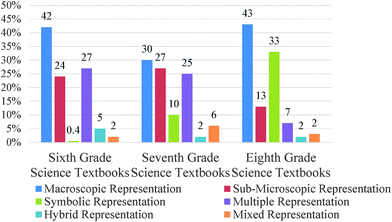 | ||
| Fig. 3 Distribution of representation types (%) in middle school science textbooks with respect to grade levels. | ||
It is shown in Fig. 3 that macroscopic representations have similar usage prevalence in the sixth and eighth grade Turkish middle school science textbooks (respectively 42%; 43%). One of the significant findings is that the ratio of macroscopic representations decreases to 30% in the seventh grade science textbooks although the number of objectives (46) about the PNM was the highest at this grade level whereas the number of macroscopic images in the eighth grade science textbooks increased even though the number of objectives (17) about the PNM was the lowest at this grade level.
On the other hand, sub-microscopic representations have a similar usage ratio for the sixth and seventh grade Turkish middle school science textbooks (respectively 24%; 27%). The usage ratio of sub-microscopic representations is also low in eighth grade science textbooks (13%). It is about half of the ones in the sixth and seventh grade Turkish middle school science textbooks (13%). While increasing in grade levels, it was expected that the usage of sub-microscopic images should be higher than that of the lower grades' science textbooks. Moreover, the gap between the percentage of macroscopic images (43%) and submicroscopic images (13%) was large in the eighth grade science textbooks.
In relation to Fig. 3, the percentage of symbolic representations increased from 0.4% in the sixth grade science textbooks to 10% in the seventh grade science textbooks and reached to the highest level in the eighth grade science textbooks (33%). This increase in percentage of symbolic representation by grade level is an expected outcome of the current study since students have learned more symbols and formulae as they have been introduced to more topics such as chemical reactions and bonding in the eighth grade. However, there was a huge gap between the percentages of symbolic representations (33%) and submicroscopic representations (13%) in the eighth grade textbooks. On the other side, the percentage of symbolic representations in the seventh grade science textbooks could be higher since there are topics like elements and their symbols and compounds in the curriculum. Moreover, there was a sharp increase in the use of symbolic representations from 10% in the seventh grade science textbooks to 33% in the eighth grade science textbooks.
The occurrence of multiple representations decreased from 27% in the sixth grade science textbooks to 25% in the seventh grade science textbooks. These conclusions show that almost one out of four images are multiple representations in the sixth and seventh grade science textbooks. Interestingly, the usage prevalence was just 7% in the eighth grade science textbooks. This is also a surprising result because there is a sharp drop from 25% to 7% which is a very low value for multiple representations in the eighth grade science textbooks.
Hybrid and mixed representations had the lowest usage levels for all middle school grades' science textbooks. Hybrid representations decreased from 5% in sixth grade science textbooks to 2% in seventh and eighth grade science textbooks. The low percentage of hybrid representations in middle school science textbooks could seem to be an affirmative outcome because of the high possibility of causing students’ misconceptions. Fig. 4 is as an example of a hybrid representation taken from a sixth grade science textbook. The image represents water both macroscopically and sub-microscopically without any signs showing the differences between the two types of representations in an image that may lead students to misinterpret sizes and distances between water and sugar molecules.
Likewise, the existence of mixed representations decreased from 6% in seventh grade science textbooks to 2% in sixth and eighth grade science textbooks. Fig. 5 is an example of an image of a mixed representation. The image indicates that bees enter and leave a hive without constraint. This situation represents how gas molecules move freely in an analogical perspective. However, mixed representations should be clearly linked with the text to show students how these representations with a given analogy relate to each other.
(3) About the images about the PNM used in middle school science textbooks;
(a) What is the degree of relatedness to texts?
Table 2 shows the distribution of relatedness to texts with respect to grade levels. It was found that 4 out of 10 images were completely related and linked. In addition, whereas one third of images were completely related, they were unlinked with texts. Moreover, 19% of the images were found to be partially related to the text. In other words, one fifth of the images used, in units about the PNM, were partially related to the text. Lastly, 4% of the images were unrelated.
| Completely related and linked | Completely related and unlinked | Partially related and linked | Partially related and unlinked | Unrelated | ||||||
|---|---|---|---|---|---|---|---|---|---|---|
| f | % | f | % | f | % | f | % | f | % | |
| Sixth grade | 95 | 38 | 76 | 30 | 18 | 7 | 59 | 23 | 5 | 1 |
| Seventh grade | 195 | 47 | 167 | 40 | 9 | 2 | 33 | 8 | 12 | 3 |
| Eighth grade | 63 | 40 | 38 | 24 | 8 | 5 | 36 | 23 | 12 | 7 |
| Total | 353 | 43 | 281 | 34 | 35 | 4 | 128 | 15 | 29 | 4 |
In the sixth grade textbooks, a total of 53% of the images were unlinked with the text either completely related (30%) or partially related (23%). In the seventh and eighth grade textbooks, almost half of the images (48% and 47% respectively) were unlinked with the text either completely related (40%, and 24%) or partially related (8%, and 23%).
Completely related and linked images are at the highest ratio (47%) in seventh grade science textbooks. They decreased to 40% in eighth grade and 38% in sixth grade science textbooks. Indeed, it was expected that the relation between the text and image should be the highest in the sixth grade science textbooks because this was when the students are first taught about the PNM and related concepts. In addition, the images, which were completely related but had no link to the text, were again mostly in the seventh grade science textbooks. The value decreased to 30% in the sixth grade science textbooks and to 24% in the eighth grade science textbooks.This kind of text-image combination could be the highest in eighth grade science textbooks as the students' metacognition levels are biologically higher at this grade than that of sixth and seventh grade students.
Partially related and linked images increased from 2% in seventh grade science textbooks to 5% in eighth grade and 7% in sixth grade science textbooks. Similarly, the usage of partially related and unlinked images increased from 8% in seventh grade science textbooks to 23% in sixth and eighth grade science textbooks.
Finally, the unrelated images decreased from 7% in eighth grade science textbooks to 3% in seventh grade and 1% in sixth grade science textbooks.
(b) What are the properties of the captions?
The properties of captions were categorized into three different sub-titles which were suitable, problematic and no caption. Fig. 6 summarizes the distribution of the properties of captions with respect to the grade levels.
It is was found that out of all the middle school science textbooks, the eighth grade science textbooks contained the highest number of visuals about PNM which had suitable captions (54%). This value decreased to 37% in seventh grade science textbooks and reached the lowest ratio for the representations in sixth grade science textbooks (32%). It is interesting that the ratio of suitable captions in middle school science textbooks decreased from the eighth grade to the sixth grade.
A remarkable finding was that over half of the images (63%) in sixth grade science textbooks had no caption. It decreased to 51% in seventh grade science textbooks and 36% in eighth grade science textbooks. This result may show that students have trouble understanding the messages carried by the images.
For the images with problematical captions, the value increased from 5% in sixth grade science textbooks to 10% in eighth grade science textbooks and 12% in seventh grade science textbooks.
Discussion
Knowing that teaching and learning strategies depend heavily on textbooks, researchers should investigate more carefully the pedagogical potential of photographs and how students and teachers make use of these visual resources to achieve and help others to achieve understanding (Pozzer Ardenghi and Roth, 2004). In this study, the research questions were about the amount of images, types of representations, captions' properties and the relation between the text and images about the PNM in Turkish middle school science textbooks.The findings revealed that macroscopic representations are used widely in middle school science textbooks. This consequence emphasizes that the PNM is usually taught by concrete concepts in science textbooks. It is an indispensable fact that macroscopic representations play important roles in the teaching process especially for the introduction of new concepts to students (Johnstone, 2007). Also the interest of students is increased when they are taught with this type of representation (Harrison and Treagust, 2003). On the other hand, due to the fact that the topic includes a lot of abstract concepts, representing the topic with a high incidence of macroscopic images in science textbooks can give contradictory results. It is also interesting that the most common representation type is the macroscopic one in eighth grade science textbooks because it is usual that an increase in the grade level is parallel to the increment in understanding of abstract concepts. The characteristics of the images needed for teaching differ greatly depending upon the students' age or achievement level (Pinto, 2002). Dimopoulos et al. (2003) had similar findings. They analyzed textbooks and scientific articles published by newspapers and concluded that visuals on these materials are mainly real copies of themselves.
A significant finding of this study is the indication of the low use of sub-microscopic representations in middle school science textbooks. Surprisingly, this kind of representation is at the lowest level in eighth grade science textbooks. Just 1 out of 10 images was at the sub-microscopic level in eighth grade science textbooks. This was found to be similar for sixth and seventh grade science textbooks since there were merely 2 or 3 out of 10 visuals at the sub-microscopic level. Owing to the fact that the sub-microscopic level plays an important role in helping students to develop a mental image of the sub-micro level which is vital because chemical explanations nearly always depend on the sub-micro level (Chittleborough and Treagust, 2007; Davidowitz and Chittleborough, 2009) and the PNM covers many intangible concepts, it was supposed that there could be more sub-microscopic representations in middle school science textbooks.
Submicroscopic entities are real but they are too small to be observed, so chemists describe their characteristics and behavior by using symbolic representations to construct mental images (Treagust et al., 2003). They are mostly present in eighth grade science textbooks which was an expected outcome because the eighth grade curriculum requires using them frequently. Nevertheless, although the seventh grade curriculum involves concepts like atom, molecule and compound, symbolic representations meaning the chemical expression of these, were used for just 1 out of 10 images. The study done by Bunce and Gabel (2002) also supported the idea that chemistry education in schools does not emphasize the submicroscopic level of chemical concepts. Nonetheless, not understanding the meaning of the symbolic languages makes it difficult to understand the concepts or ideas (Taber, 2009). In order to deal with this situation, symbolic representations could be used much more in the units about the PNM in seventh grade science textbooks. There was just one symbolic representation in the sixth grade science textbooks which may be due to the fact that the sixth grade curriculum does not cover the topics such as elements, compounds and chemical reactions which include highly intensive symbolic images.
There was a notable finding about multiple representations which mean the use of combinations of representations. They were found to have the lowest prevalence in eighth grade science textbooks. The use of this type of representation is more than three times greater in both sixth and seventh grade science textbooks. This result conflicts with earlier studies (Gabel, 1993; Chittleborough et al., 2005) which advocated ensuring a transition between representational levels to increase the achievement in chemistry education. Ainsworth (1999) also claimed that learners are less likely to be exposed by the strengths and weakness of any single representation, when they take advantage of multiple representations.
The classification of representations as multiple, hybrid and mixed in textbooks is significant since each of them has different purposes and functions for teachers' utilization and student learning so they have both strengths and weaknesses. Therefore, educators especially teachers who utilize textbooks most should carefully select and use images in their teaching based on considering possible weaknesses as well as benefits. For example, in hybrid representations, two representations are embedded in an image without any guide to help readers understand differences between representations. As a result, hybrid representations have potential to cause alternative conceptions. In another respect, Justi and Gilbert (1999) advocated that using hybrid models in teaching means that scientific knowledge is context independent and this leads students to have alternative conceptions in their mental models (p. 173).
Similar to hybrid representations, mixed representations are occasionally used in middle school science textbooks. Mixed representations may enable students to connect processes or concepts with an event from daily life which may give rise to meaningful and deeper learning. Nevertheless, this can only occur if students see how the two representations relate to each other (Ainswort et al., 1997, p. 100). Mixed representations should also be carefully used by teachers and textbook authors due to their complex analogical perspective. Although analogies can be influential teaching tools, it is agreed that not all analogies are good and that not all good analogies are useful to all students (Orgill and Bodner, 2004). Analogies have been called ‘double-edged swords’ since the appropriate knowledge they can make is often associated with alternative conceptions (Taber, 2005; Bellecchi and Ritchie, 2011; Nakiboğlu and Taber, 2013). Moreover, the pedagogical implications of multiple representations suggest that teachers cannot simultaneously present different types of representations in teaching difficult science concepts. Otherwise, students would become overloaded with information and be unable to see the connections between the levels (Treagust, 2007). In addition, there are studies (e.g.Ainswort et al., 1996) in the literature which show that students had a low performance and understanding when they used mixed pictorial and mathematical representations instead of using pictorial and symbolic representations separately.
Another crucial result was about the relation between images and texts. Paivio (1986) advocated that information can be recalled and manipulated more easily if it is encoded in verbal and visual systems. This means that students might be exposed to meaningful and deeper learning if their cognitive systems are stimulated by two stimuli. In other words, just texts or just images are not enough for meaningful understanding. When these two representation types are presented together, interpretation of ambiguous representation (e.g. just text) may be constrained by the specific representation (e.g. an image) independently of issues of familiarity or experience (Ainsworth, 1999, p. 140). In the current study, it was found that just four images about the PNM were completely related and linked with the text. Pozzer Ardenghi and Roth (2004) stated that the main text is certainly an important resource in helping readers to interpret photographs. It would be difficult for students to correctly interpret images if they are not related or linked to the main text. Almost half of the images about the PNM in Turkish middle school science textbooks were unlinked to the main text. Furthermore, one fifth of images were partially related to the text. Pinto and Ametller (2002) stated that it is not only a badly designed image but also a lack of information in the main text that makes it difficult to understand an image. Based on the findings of the current study, the coherence between images about the PNM in Turkish middle school science textbooks and texts is weak.
Finally, captions are also one of the vital components of images that tell the reader what to look for in an image and therefore how to read and understand it (Pozzer and Roth, 2003). Whereas surface features of representations clarify the labelled part, captions explain the entire representation mission. For the images about the PNM in Turkish middle school science textbooks, more than half of them had no caption. It is also noteworthy that images with no caption were mostly found in sixth grade science textbooks despite the fact that this was the first time that students in this grade had been taught about the PNM. Captions can be helpful, especially in the case of unfamiliar concepts; with no caption, they would remain a mystery (Woodward, 1993). The numbers of visuals with no caption decreased with an increase in the grade levels. Approximately 4 out of 10 representations in middle school science textbooks had suitable captions. Furthermore, even some visuals had captions; they were problematical which meant that the caption did not explain what the representation wanted to teach. Overall, these results emphasize that captions are not used appropriately for teaching the concepts of the PNM in Turkish middle school science textbooks.
Suggestions
The findings of the current study provide some suggestions for science teachers, textbook publishers and researchers.First of all, owing to the fact that science teachers have a vital role through teaching chemistry concepts, several suggestions are offered. Since students have difficulty when they are faced with concepts at different representational levels (Chittleborough and Treagust, 2008; Nyachwaya et al., 2011), science teachers should emphasize the representation of the concept at different levels. For example, teachers may instruct students to focus on the similarities and differences between the representations of ice, water and water vapor molecules in science textbooks. In this respect, students should be able to understand the concept at different representational levels. In order to achieve this, teachers may use images in textbooks, conceptual models or technology enhanced teaching tools (e.g. computer based models). Furthermore teachers may provide other sources such as scientific journals, the internet and so on, to enable the students to see different images and different types of representations of the same concept. It is also important to state that multiple representations decrease with respect to grade levels. Nevertheless, the number of multiple representations is expected to increase according to grade levels because in the higher grades, there are objectives about the PNM which require a combination of different representational levels. In this respect, it is important for teachers to mention multiple representations especially to students in higher grades. If the images have no caption or a lack of relation with the text in order to be sure of the students' understanding of the images, teachers may want their students to explain the images or could have classroom discussions about the topic using the images. For example teachers may present the image with no caption or/and lack of relation to the text and enable students to say their views about the image and try to reveal what they understand from the image.
Secondly, textbook authors and publishers have important responsibilities through the writing of textbooks. In Turkey, the Head Council of Education and Morality determines the textbooks which are used in schools. The members of this council should consider carefully how images have been used in textbooks as a part of evaluation criteria. The results of the current study indicate that many visuals have been used in Turkish middle school science textbooks. Course books which contain a lot of images are not necessarily of a high quality. For this reason, while determining images in textbooks, textbook authors should consider the aim of the representations. Instead of using too many images to make the textbooks colorful and attractive, authors might try to use images from different representational levels which are directly related to the the topic and text which would be remarkable for the students. Moreover, there are macroscopic representations in most Turkish middle school science textbooks but the PNM covers a lot of abstract concepts. Therefore, textbook authors should consider whether the images presented are appropriate for the concepts discussed. For example ball and stick models might be used while teaching atom or molecule concepts in textbooks, instead of using a photo of the element itself. The same concept or event should be shown using images at different representational levels. In this way, students might be able to see the same concept at different levels. Another suggestion for textbook authors and publishers is about the relation between the text and images in textbooks and image captions. Because there is a limited number of images about the PNM which are completely related and linked in Turkish middle school science textbooks, understanding the meaning of these images may be problematical for students. Also, almost half of these images have no caption. When images have no caption, it is difficult to understand what the image involves and what the aim of it is. Thus textbook authors should be careful about using suitable captions for images in textbooks.
Thirdly, suggestions for future research are offered as these are the limitations of the current study. For instance, the number of images and how often they have been using by teachers in their classes could be investigated. Moreover further research could be done on how students interpret these images in a science classroom. A similar textbook analysis may be carried out for different topics in order to reveal how multiple representations are used in science textbooks. Chemical reactions and bonding, solutions and acids and bases are possible topics from chemistry education.
Appendix 1
This page was taken from sixth grade science textbooks and the images on this were not evaluated in the study since they are in the activity part of the unit.This page was taken from sixth grade science textbooks and the images on this page were also not evaluated in the study since they are in the assessment part of the unit.
This page was taken from sixth grade science textbooks and the images on this page were evaluated in the study since they are in the teaching part of the unit.
Appendix 2
1st criterion (C1): types of representation
An ice photo from a sixth grade science textbook
Atom models from sixth grade science textbooks
Ions and formulae of compounds from eighth grade science textbook
An image from a sixth grade science textbook which indicates water by separate representations as macroscopically and sub-microscopically
An image from a sixth grade science textbook which indicates water and its molecules by unique image which consists of macroscopic and sub-microscopic representations embedded together
An image from a sixth grade science textbook which indicates end of a school day and students leaving the school. The image is used analogically since each student represents a gas molecule and gas molecules are independent from each other. They can spread easily.
2nd criterion (C2): relatedness to text
The image is from a sixth grade science textbook. The text explains that iodine comprises of iodine molecules and water is composed of water molecules. Two of these are element and compound, respectively. On the other hand, mixtures consist of different atoms and molecules as they are composed of different matter. Examples are given of an element, compound and mixture by images. In addition, the text involves phrases like ‘as shown the photograph’.
The image is from a sixth grade science textbook. The text explains that we can understand gas particles are moveable because the smell of a meal spreads from the kitchen to other rooms in the home. The text is completely related to the image but there is no phrase such as ‘as shown in the figure’ or ‘the image shows that’.
The image is from a sixth grade science textbook. The text explains that pure substances are examined into two sub-categories (elements and compounds). As you see hydrogen(II) and oxygen(IV) are molecular elements but water is a compound. If a compound is formed by molecules, then each molecule of that compound is the same. Matters also can be formed by atoms. For example, He atom (I) has an atomic structure. Namely, the text does not fully explain the image since it is difficult to see which image represents which element or compound. It is relevant to the images and includes a link for students to examine the visual.
The image is from a sixth grade science textbook. The text explains the vibrational motion of atoms/molecules in all phases and the reciprocating motion of atoms/molecules in liquid and gas phases, but there is not much relation between the text and the image. Furthermore, there is no link in the text
The image is from a sixth grade science textbook and the text explains that compounds are formed by a combination of various atoms. Nonetheless, it does not directly explain the image and there is no link for students to view the image.
3rd criterion (C3): properties of captions
References
- Adadan E. and Savasci F., (2012), An analysis of 16–17 year-old students' understanding of solution chemistry concepts using a two-tier diagnostic instrument, Int. J. Sci. Educ., 34(4), 513–544. DOI: http://10.1080/09500693.2011.636084.
- Adadan E., Irving K. E. and Trundle K. C., (2009), Impacts of multi-representational instruction on high school students' conceptual understandings of the particulate nature of matter, Int. J. Sci. Educ., 31(13), 1743–1775.
- Ainsworth S., (1999), The functions of multiple representations, Computer & Education, 33, 131–152.
- Ainsworth S., (2006), DeFT: a conceptual framework for considering learning with multiple representations, Learn. Instr., 16(3), 183–198.
- Ainsworth S., (2008), The educational value of multiple-representations when learning complex scientific concepts, in Gilbert J. K., Reiner ve M. and Nakhleh M. (ed.), Visualization: Theory and Practice in Science Education, Springer, pp. 191–208.
- Ainswort S., Bibby P. and Wood D., (1996), Co-ordinating multiple representations in computer based learning environments. Proceedings of the European Conference on Artificial Intelligence and Education, Lisbon: Ediçoes Colibri.
- Ainswort S., Bibby P. and Wood D., (1997), Information technology and multiple representations: new opportunities-new problems, Journal of Information Technology for Teacher Education, 6(1), 93–105.
- Akaygun S. and Jones L. L., (2014), Words or pictures? A comparison of written and pictorial explanations of physical and chemical equilibria, Int. J. Sci. Educ., 36(5), 783–805.
- Ayas A. and ve Özmen H., (2002), Lise kimya öğrencilerinin maddenin tanecikli yapısı kavramını anlama seviyelerine ilişkin bir çalışma, Boğaziçi Üniversitesi Eğitim Dergisi, 19(2), 45–60.
- Bellecchi A., and Ritchie S. M., (2011), Investigating and theorizing discourse during analogy writing in chemistry, J. Res. Sci. Teach., 48(7), 771–792.
- Boz Y., (2006), Turkish pupils' conceptions of the particulate nature of matter, J. Sci. Educ. Technol., 15(2), 203–213.
- Bucat B. and Mocerino M., (2009), Learning at the sub-micro level: structural representations, in Gilbert J. K. and Treagust D. F. (ed.), Models and Modelling in Science Education: Multiple Representations in Chemical Education, Netherlands: Springer, pp. 11–30.
- Buckley B. C., (2000), Interactive multimedia and model-based learning in biology, Int. J. Sci. Educ., 22(9), 895–935.
- Buckley B. C. and Boulter C. J., (2000), Investigating the role of representations and expressed models in building mental models, in Gilbert J. K. and Boulter C. J. (ed.), Developing Models in Science Education, Dordrecht, the Netherlands: Kluwer, pp. 119–135.
- Bunce D. M. and Gabel D., (2002), Differential effects on the achievement of males and females of teaching the particulate nature of chemistry J. Res. Sci. Teach., 39(10), 911–927.
- Çalık M. and ve Kaya E., (2012), Fen ve teknoloji ders kitaplarında ve öğretim programındaki benzetmelerin incelenmesi, İlköğretim Online, 11(4), 856–868.
- Chandrasegaran A. L., Treagust D. F. and Mocerino M. (2007), The development of a two-tier multiple-choice diagnostic instrument for evaluating secondary school students' ability to describe and explain chemical reactions using multiple level of representation. Chemistry Education Research and Practice, 8(3), 293–307.
- Cheng M. M. W. and Gilbert J. K., (2014), Students' visualization of metallic bonding and the malleability of metals, Int. J. Sci. Educ., 36(8), 1373–1407.
- Cheng M. M. W. and Gilbert J. K., (2015), Students' visualization of diagrams representing the human circulatory system: the use of spatial isomorphism and representational conventions, Int. J. Sci. Educ., 37(1), 136–161.
- Chiang-Soong B. and Yager R., (1993), Readability levels of the science textbooks most used in secondary schools, Sch. Sci. Math., 93, 24–27.
- Chiappetta E. L., Ganesh T. G., Lee Y. H. and Phillips M. C., (2006), Examination of science textbook analysis research conducted on textbooks published over the past 100 years in the United States, Proceedings from annual meeting of the National Association for Research in Science Teaching, San Francisco, CA.
- Chittleborough G. and Treagust D., (2007), The modeling ability of non-major chemistry students and their understanding of the sub-microscopic level, Chem. Educ. Res. Pract., 8(3), 274–292.
- Chittleborough G. and Treagust D., (2008), Correct interpretation of chemical diagrams requires transforming from one level of representation to another, Res. Sci. Educ., 38, 463–482.
- Chittleborough G., Treagust D. and Mocerino M., (2005), Non-major chemistry students' learning strategies: explaining their choice and examining the implications for teaching and learning, Sci. Educ. Int., 16(1), 5–21.
- Cook M. P., (2006), Visual representations in science education: the influence of prior knowledge and cognitive load theory on instructional design principles, Sci. Educ., 90(6), 1073–1091.
- Davidowitz B. and Chittleborough G., (2009), Linking the macroscopic and sub-microscopic levels: Diagrams, in Gilbert J. K. and Treagust D. F. (ed.), Multiple Representations in Chemical Education, Netherlands: Springer, pp. 169–191.
- De Vos W. and Verdonk A. H., (1996), The particulate nature of matter in science education and in science, J. Res. Sci. Teach., 33(6), 657-664.
- Dimopoulos K., Koulaidis V. and Sklaveniti S., (2003), Towards an analysis of visual images in school science textbooks and press articles about science and technology, Res. Sci. Educ., 33, 189–216.
- Dökme İ., (2005), MEB ilköğretim 6.sınıf fen bilgisi ders kitabının bilimsel süreç becerileri yönünden değerlendirilmesi, İlköğretim Online, 4(1), 7–17.
- Dori Y. J. and Hameiri M., (2003), Multidimensional analysis system for quantitative chemistry problems: symbol, macro, micro and process aspects, J. Res. Sci. Teach., 40(3), 278–302.
- Ertok Atmaca A., (2006), İlköğretim ders kitaplarında görsel tasarım ve resimleme, Milli Eğitim Dergisi, 171, 318–328.
- Gabel D. L., (1993), Use of the particulate nature of matter in developing conceptual understanding, J. Chem. Educ., 70(3), 193–194.
- Gabel D. L., (1999), Improving teaching and learning through chemistry education research: a look to the future, J. Chem. Educ., 76(4), 548–554.
- Geban Ö. and ve Bayır G., (2000), Effect of conceptual change approach on students' understanding of chemical change and conversation of matter, Hacettepe Üniversitesi Eğitim Fakültesi Dergisi, 19, 79–84.
- Gilbert J. K., (2004), Models and modelling: routes to more authentic science education, Int. J. Sci. Educ., 2, 115–130.
- Gilbert J. K., (2010), The role of visual representations in the learning and teaching of science: an introduction, Asia-Pacific Forum on Science Learning and Teaching, 11(1), 1–19.
- Gkitzia V., Salta K. and Tzougraki C., (2011), Development and application of suitable criteria for the evaluation of chemical representations in school textbooks, Chem. Educ. Res. Pract., 12, 5–14.
- Griffiths A. K. and Preston K. R., (1992), Grade-12 students' misconceptions relating to fundamental characteristics of atoms and molecules, J. Res. Sci. Teach., 29(6), 611–628.
- Gustafson B. J., Shanahan M.-C. and Gentilini S., (2010), Elementary children's shifting views of models and the nature of matter, Canadian Journal of Science, Mathematics and Technology Education, 10(2), 103–122.
- Haidar A. H., (1997), Prospective chemistry teachers' conceptions of the conservation of matter and related concepts, J. Res. Sci. Teach., 34(2), 181–197.
- Han J. and Roth W., (2005), Chemical inscriptions in Korean textbooks: semiotics of macro- and micro world, Sci. Educ., 90, 173–201.
- Harrison A. G. and Treagust D. F., (1996), Secondary students' mental models of atoms and molecules: implications for teaching chemistry, Sci. Educ., 80(5), 509–534.
- Harrison A. G. and Treagust D. F., (1998), Modelling in science lessons: are there better ways to learn with models? Sch. Sci. Math., 98(8), 420–429.
- Harrison A. G. and Treagust D. F., (2000), Learning about atoms, molecules and chemical bonds: a case study of multiple-model use in grade 11 chemistry, Sci. Educ., 84(3), 352–381.
- Harrison A. G. and Treagust D. F., (2003), The particulate nature of matter: challenges in understanding the submicroscopic world, in Gilbert J. K., De Jong O., Justi R., Treagust D. F. and Van Driel J. H. (ed.), Chemical Education: Towards Research-Based Practice, Dordrecht: Kluwer Academic Publishers, pp. 189–212.
- Ingham A. M. and Gilbert J. K., (1991), The use of analogue models by students of chemistry at higher education level, Int. J. Sci. Educ., 13(2), 193–202.
- Irving K. E., Savaşcı-Açıkalın F. and Wang T. L., (2006), Multiple representations of the particulate nature of matter, paper presented at the annual meeting for the National Association for Research in Science Teaching International Conference, San Francisco, CA.
- Johnstone A. H., (1993), The development of chemistry teaching: a changing response to changing demand, J. Chem. Educ., 70(9), 701–705.
- Johnstone A. H., (2007), Science education: we know the answers, let's look at the problems, Proceedings of the 5th Greek Conference “Science education and new technologies in education”, 1, 1–11.
- Justi R. and Gilbert J., (1999), A cause of ahistorical science teaching: use of hybrid models, Sci. Educ., 83(2), 163–177.
- Karamustafaoğlu O. and Üstün A., (2005), Türkiye'de yürürlükte olan fen bilgisi 7.sınıf ders kitabının değerlendirilmesi: bir durum çalışması, Erzincan Eğitim Fakültesi Dergisi, 7(1), 1–14.
- Kavak N., (2007), Maddenin tanecikli doğası hakkında ilköğretim 7.sınıf öğrencilerinin imaj oluşturmalarına rol oynama öğretim yönteminin etkisi, Gazi Eğitim Fakültesi Dergisi, 27(2), 327–339.
- Kenan O. and ve Özmen H., (2011), Maddenin tanecikli yapısı ünitesine yönelik zenginleştirilmiş bilgisayar destekli bir öğretim materyalinin tanıtımı, Proceedings from 5th International Computer & Instructional Technologies Symposium, Fırat University, Elazığ-Turkey.
- Kozma R. B. and Russell J., (1997), Multimedia and understanding: Expert and novice responses to different representations of chemical phenomena, J. Res. Sci. Teach., 34(9), 949–968.
- Kress G. R. and Van Leeuwen T., (1996), Reading images: the grammar of visual design, Oxfordshire: Psychology Press.
- Lee V. R., (2010), Adaptations and continuities in the use and design of visual representations in US middle school science textbooks, Int. J. Sci. Educ., 32(8), 1099–1126.
- Lee O., Eichinger D. C., Anderson C. W., Berkheimer G. D. and Blakeslee T. D., (1993), Changing middle school students' conceptions of matter and molecules, J. Res. Sci. Teach., 30(3), 249–270.
- Margel H., Eylon B. and Scherz Z., (2008), A longitudinal study of junior high school students' conceptions of the structure of materials, J. Res. Sci. Teach., 45(1), 132–152.
- MEB (Ministry of National Education) (2013a), Science education curriculum for graders 3, 4, 5, 6, 7 and 8, retrieved 17 March 2015, from http://ttkb.meb.gov.tr/www/guncellenen-ogretim-programlari/icerik/151.
- MEB (Ministry of National Education) (2013b), Chemistry education curriculum for graders 9, 10, 11 and 12, retrieved 17 March 2015, from http://ttkb.meb.gov.tr/www/guncellenen-ogretim-programlari/icerik/151.
- Nakhleh M. B. and Samarapungavan A., (1999), Elementary school children's beliefs about matter, J. Res. sci. Teach., 36(7), 777–805.
- Nakhleh M. B., Samarapungavan A. and Saglam Y., (2005), Middle school students' beliefs about matter, J. Res. Sci. Teach., 42(5), 581–612.
- Nakiboğlu C., (2009), Deneyimli kimya öğretmenlerinin ortaöğretim kimya ders kitaplarını kullanımlarının incelenmesi, Ahi Evran Üniversitesi Kırşehir Eğitim Fakültesi Dergisi (KEFAD), 10(1), 1–10.
- Nakiboğlu C., and Taber K. S., (2013), The atom as a tiny solar system: Turkish high school students' understanding of the atom in relation to a common teaching analogy, in Tsaparlis G. and Sevian H. (ed.), Concepts of Matter in Science Education, London: Springer, pp. 169–198.
- Niaz M. and Fernandez R., (2008), Understanding quantum numbers in general chemistry textbooks, Int. J. Sci. Educ., 30(7), 869–901.
- Nyachwaya J. M. and Wood N. B., (2014), Evaluation of chemical representations in physical chemistry textbooks, Chem. Educ. Res. Pract., 15, 720–728.
- Nyachwaya J. M., Mohamed A., Roehrig G. H., Wood N. B., Kern A. L. and Schneider J. L., (2011), The development of an open-ended drawing tool: an alternative diagnostic tool for assessing students' understanding of the particulate nature of matter, Chem. Educ. Res. Pract., 12, 121–132.
- Orgill M. K. and Bodner G., (2004), What research tells us about using analogies to teach chemistry, Chem. Educ.: Res. Pract., 5(1), 15–32.
- Özalp D. and ve Kahveci A., (2011), Maddenin tanecikli yapısı ile ilgili iki aşamalı tanılayıcı soruların ontoloji temelinde geliştirilmesi, Eğitim ve Sosyal Bilimler Dergisi, 191, 135–156.
- Özmen H., (2011), Turkish primary students' conceptions about the particulate nature of matter, Int. J. Environ. Sci. Educ., 6(1), 99–121.
- Özmen H. and Kenan O., (2007), Determination of the Turkish primary students' views about the particulate nature of matter, Asia-Pacific Forum on Science Learning and Teaching, 8(1), 1–15.
- Paivio A., (1986), Mental representations: a dual coding approach, New York: Oxford Science Publications.
- Pinto R., (2002), Introduction to science teacher training in an information society (STTIS) project, Int. J. Sci. Educ., 24(3), 227–234.
- Pinto R. and Ametller J., (2002), Students' difficulties in reading images. Comparing results from four national research groups, Int. J. Sci. Educ., 24(3), 333–341.
- Pozzer Ardenghi L. and Roth W., (2004), Students' interpretation of photographs in high school biology textbooks. Annual Meeting of the National Association for Research in Science Teaching, Vancouver, BC, April 1–4.
- Pozzer Ardenghi L. and Roth W., (2005), Making sense of photographs, Sci. Educ., 89(2), 219–241.
- Pozzer L. L. and Roth W., (2003), Prevalence, function and structure of photographs in high school biology textbooks, J. Res. Sci. Teach., 40(10), 1089–1114.
- Rapp D., (2005), Mental models: theoretical issues for visualizations in science education, in Gilbert J. K. (ed.), Visualization in Science Education, Netherlands: Springer, pp. 43–60.
- Roth W., McGinn M. K. and Bowen G. M., (1998), How prepared are pre-service teachers to teach scientific inquiry? Levels of performance in scientific representation practices, J. Res. Sci. Teach., 36, 977–1019.
- Roth W., Bowen G. M. and McGinn M. K., (1999), Differences in graph related practices between high school biology textbooks and scientific ecology journals, J. Res. Sci. Teach., 36(9), 977–1019.
- Sanchez G. and Valcarcel M. V., (1999), Science teachers' views and practices in planning for teaching, J. Res. Sci. Teach., 36(4), 493–513.
- Savenye W. C. and Robinson R. S., (2004), Qualitative research issues and methods: an introduction for educational technologists, in Jonassesn D. H. (ed.), Handbook of Research on Educational Communications and Technology, New Jersey: Lawrence Erlbaum, 2nd edn, pp. 1045–1071.
- Şen A. Z. and ve Nakiboğlu C., (2012), Ortaöğretim kimya ders kitaplarının bilimsel süreç becerileri açısından incelenmesi, Ahi Evran Üniversitesi Kırşehir Eğitim Fakültesi Dergisi, 13(3), 47–65.
- Sherman R. R. and Webb R. B., (1988), Qualitative research in education: a focus, in Sherman R. R. and Webb R. B. (ed.), Qualitative Research Methods in Education: Focus and Methods, London: Falmer Press, pp. 2–20.
- Skoog G., (2005), The coverage of human evolution in high school biology textbooks in the 20th century and in current state science standards, Sci. Educ., 14, 395–422.
- Snir J., Smith C. L. and Raz G., (2003), Linking phenomena with competing underlying models: a software tool for introducing students to the particulate model of matter, Sci. Educ., 87(6), 794–830.
- Taber K. S., (2005), Mind your language: metaphor can be a double-edged sword, Phys. Educ., 40(11), 11–12.
- Taber K. S., (2009), Learning at the symbolic level, in Gilbert J. K. and Treagust D. (ed.), Models and Modelling in Science Education: Multiple Representations in Chemical Education, Netherlands: Springer, pp. 75–109.
- Taber K. S., (2012), The international dimension of chemistry education and practice, Chem. Educ. Res. Pract., 13, 398–400.
- Tekbıyık A., (2006), Lise fizik I dersi okunabilirliği ve hedef yaş düzeyine uygunluğu, Kastamonu Eğitim Dergisi, 14(2), 441–446.
- Tezcan H. and Salmaz Ç., (2005), Atomun yapısının kavratılmasında ve yanlış kavramların giderilmesinde bütünleştirici ve geleneksel öğretimlerinin etkileri, Gazi Eğitim Fakültesi Dergisi, 25(1), 41-54.
- Treagust D. F., (2007), General instructional methods and strategies, in Abell S. K., and Lederman N. G., Handbook of Research on Science Education, New York: Routledge, pp. 373–391.
- Treagust D. F., Harrison A. G. and Venville G., (1998), Teaching science effectively with analogies: an approach for pre-service and in-service teacher education, J. Sci. Teacher Educ., 9, 85–101.
- Treagust D. F., Chittleborough G. and Mamiala T., (2003), The role of submicroscopic and symbolic representations in chemical explanations, Int. J. Sci. Educ., 25(11), 1353–1368.
- Tsai C.-C., (1999), Overcoming junior high school students' misconceptions about microscopic views of phase change: a study of an analogy activity, J. Sci. Educ. Technol., 8(1), 83–91.
- Valanides N., (2000), Primary student teachers' understanding of the particulate nature of matter and its transformations during dissolving, Chem. Educ.: Res. Pract. Eur., 1(2), 249–262.
- Vermaat H., Terlouw C. and Dijkstra S., (2003), Multiple representations in web-based learning of chemistry concepts, Proceedings from 84th annual meeting of the American Educational Research Association, Chicago IL, USA.
- Woodward A., (1993), Do illustrations serve an instructional purpose in U.S. textbooks? in Britton B. K., Woodward A. and Binkley M. (ed.), Learning from Textbooks: Theory and Practice, New Jersey: Lawrence Erlbaum, pp. 95–115.
- Wu H. K. and Shah P., (2004), Exploring visuospatial thinking in chemistry learning, Sci. Educ., 88, 465–492.
- Wu H. K., Krajcik J. S. and Soloway E., (2001), Promoting understanding of chemical representations: students' use of a visualization tool in the classroom, J. Res. Sci. Teach., 38(7), 821–842.
- Yakmaci-Guzel B. and Adadan E., (2013), Use of multiple representations in developing preservice chemistry teachers' understanding of the structure of matter, Int. J. Environ. Sci. Educ., 8(1), 109–130.
- Zoller U., (1990), Students' misunderstandings and misconceptions in college freshman chemistry (general and organic), J. Res. Sci. Teach., 27(10), 1053–1065.
| This journal is © The Royal Society of Chemistry 2015 |

